
An effects unit, effects processor, or effects pedal is an electronic device that alters the sound of a musical instrument or other audio source through audio signal processing.

Vox is a British musical equipment manufacturer founded in 1957 by Thomas Walter Jennings in Dartford, Kent, England. The company is most famous for making the Vox AC30 guitar amplifier, used by The Beatles, The Rolling Stones, The Kinks, The Yardbirds, Queen, Dire Straits, U2, and Radiohead; the Vox Continental electric organ, the Vox wah-wah pedal used by Jimi Hendrix, and a series of innovative electric guitars and bass guitars. Since 1992, Vox has been owned by the Japanese electronics firm Korg.

An instrument amplifier is an electronic amplifier that converts the often barely audible or purely electronic signal of a musical instrument into a larger electronic signal to feed to a loudspeaker. An instrument amplifier is used with musical instruments such as an electric guitar, an electric bass, electric organ, electric piano, synthesizers and drum machine to convert the signal from the pickup or other sound source into an electronic signal that has enough power, produced by a power amplifier, to drive one or more loudspeaker that can be heard by the performers and audience.

A guitar amplifier is an electronic device or system that strengthens the electrical signal from a pickup on an electric guitar, bass guitar, or acoustic guitar so that it can produce sound through one or more loudspeakers, which are typically housed in a wooden cabinet. A guitar amplifier may be a standalone wood or metal cabinet that contains only the power amplifier circuits, requiring the use of a separate speaker cabinet–or it may be a combo amplifier, which contains both the amplifier and one or more speakers in a wooden cabinet. There is a wide range of sizes and power ratings for guitar amplifiers, from small, lightweight practice amplifiers with a single 6-inch speaker and a 10-watt amp to heavy combo amps with four 10-inch or four 12-inch speakers and a 100-watt amplifier, which are loud enough to use in a nightclub or bar performance.

Marshall Amplification is a British company that designs and manufactures music amplifiers and speaker cabinets. Founded in London by shop owner and drummer Jim Marshall, the company is based in Bletchley, Milton Keynes, England. Since March 2023, Marshall Amplification has been one of several divisions of the Swedish conglomerate, the Marshall Group.
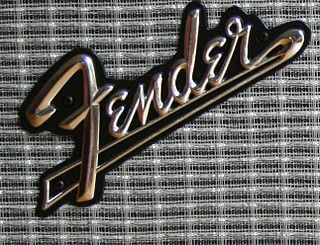
Fender amplifiers are electric instrument amplifiers produced by the Fender Musical Instruments Corporation. The first guitar amplifiers attributed to Leo Fender were manufactured by the K&F Manufacturing Corporation (K&F) between 1945 and 1946. Later, Fender began building its own line of electric guitars. Fender amplifiers would become favorites of guitarists like Jimi Hendrix, Eric Clapton, and Stevie Ray Vaughan, also known in these cases for playing Fender guitars.
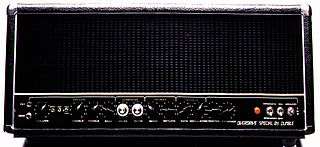
Dumble was a guitar amplifier manufacturer in Los Angeles, California.

A bass amplifier is a musical instrument electronic device that uses electrical power to make lower-pitched instruments such as the bass guitar or double bass loud enough to be heard by the performers and audience. Bass amps typically consist of a preamplifier, tone controls, a power amplifier and one or more loudspeakers ("drivers") in a cabinet.

The Fender Twin and Twin Reverb are guitar amplifiers made by Fender Musical Instruments Corporation. The Twin was introduced in 1952, two years before Fender began selling Stratocaster electric guitars. The amps are known for their characteristically clean tone.
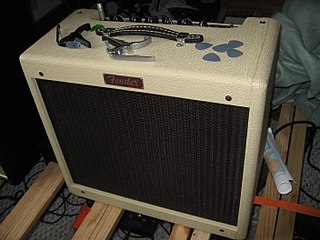
The Blues Junior is a tube guitar amplifier introduced in 1995 by the Fender Musical Instrument Corporation. It is aimed at achieving the warm, tube-driven tone common in many styles of American blues and blues rock dating back to the 1950s, while remaining both portable and affordable. A popular amp, Fender have released numerous versions since its initial release, the most recent being the version IV in 2018. Fender also frequently releases limited editions of the Blues Junior, such as the Lacquered Tweed and the "80 Proof".

The Fender Bassman is a series of bass amplifiers introduced by Fender during 1952. Initially intended to amplify bass guitars, musicians used the 5B6 Bassman to amplify other instruments, including electric guitars, harmonicas, and pedal steel guitars. Besides being a popular and important amplifier in its own right, the Bassman also became the foundation on which Marshall and other companies built their high-gain tube amplifiers.
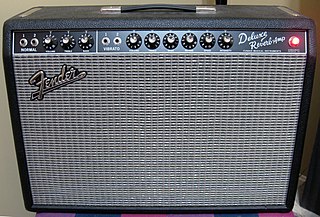
The Fender Deluxe Reverb is a guitar amplifier made by the Fender Electric Instrument Company and its successors. It was first introduced in 1963 by incorporating an onboard spring reverb tank to the newly redesigned Fender Deluxe amplifier.

The Fender Super Reverb is a guitar amplifier made by Fender. It was originally introduced in 1963 and was discontinued in 1982. The Super Reverb was a Fender Super amplifier with built-in reverb and "vibrato". The original Super Reverb amplifiers were all-tube designs and featured spring reverb. There were two different designs, distinguishable by the color of the "face" or front control panel. Super Reverbs from 1963 through 1967 had "blackface" panels. From 1968 until its discontinuation in 1982, the Super Reverb had "silverface" cosmetics and circuitry. Early models in 1968, while cosmetically "silverface", did contain "blackface" circuitry. Fender introduced a reissue '65 Super Reverb in 2001 featuring a printed circuit board design rather than the hand-wired circuitry of the original '65 Super Reverb.
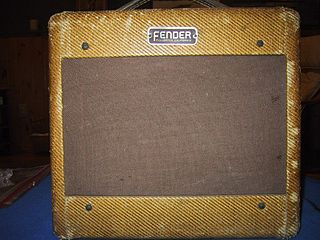
The Fender Champ was a guitar amplifier made by Fender. It was introduced in 1948 and discontinued in 1982. An updated version was introduced in 2006 as part of the "Vintage Modified" line.
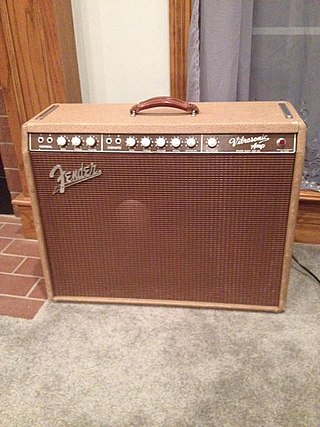
The Fender Vibrasonic was an amplifier made by Fender. It was debuted as the first of the new-model Fender amps of the 1960s, with new tolex-covered cabinets and front-mounted control panels that would replace the tweed-covered, top-panel cabinets that were prevalent during the 1950s, as well as new circuitry which would characterize most Fender amplifiers for two decades.
The Fender Bandmaster Reverb was a tube amplifier made by Fender. It was primarily a Silverface Bandmaster piggyback 'head' with the addition of reverb and vibrato and a modified circuit that shared more similarities with other Fender amplifiers. It was introduced in 1968 and was discontinued in 1980 .The Bandmaster Reverb was produced in both a 40 watt and 70 watt tube variant, before being reissued as a vintage modified amplifier.

The Fender Super was a guitar amplifier made by Fender between 1947 and 1963 and, as the Super Reverb, until 1981.
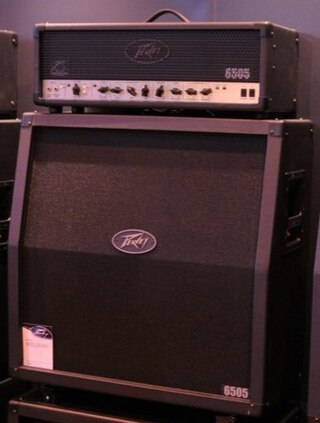
The Peavey 5150 is a vacuum tube based guitar amplifier made by Peavey Electronics from 1992 on. The amplifier was initially created as a signature model for Eddie Van Halen. After Van Halen and Peavey parted ways in 2004, the name was changed to Peavey 6505 in celebration of Peavey's 40th anniversary (1965–2005). The 5150 name was used again by Van Halen in partnership with Fender under the EVH brand in 2007 and 2011.

The Fender Princeton Reverb is a guitar amplifier combo. It is based on the Princeton and includes built-in reverb and vibrato.

The Mesa/Boogie Mark Series is a series of guitar amplifier made by Mesa Engineering. Originally just referred to as "Boogies", the product line took on the moniker "Mark Series" as newer revisions were put into production. The Mark Series amplifier was Mesa's flagship product until the introduction of the Rectifier series, and the amplifiers are collectable.

















